The Domestic Politics and Geopolitics of Renewable Energy, Part I
Trump has ceded world leadership to China. But will China do enough?
Paul Krugman
Nov 02, 2025
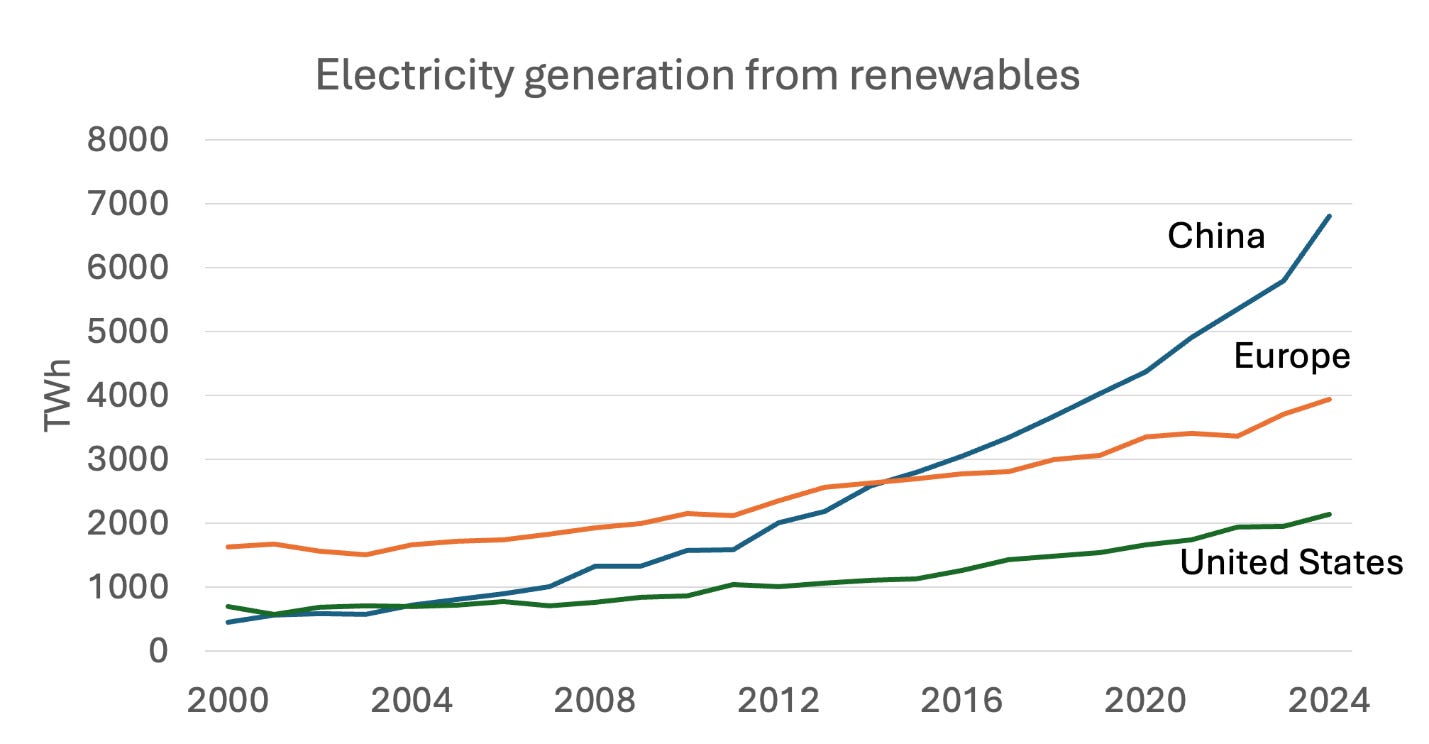
Source: Our World in Data
The world’s largest solar farm — an array of panels covering 162 square miles, 7 times the area of Manhattan — is located in a remote region of China: A desert area of the Tibetan plateau, at an altitude of almost 10,000 feet. The thin air at that altitude means more intense sunlight, and hence greater electricity output.
The United States was in the planning stages of building a somewhat smaller but still very large solar farm in Nevada, the Esmeralda 7 solar project. But a few weeks ago Trump administration officials stopped the environmental review, which has probably effectively killed it.
In last week’s primer I wrote about the remarkable global rise of renewable energy, arguably the most important technological development of the 21st century. I mentioned briefly that the current U.S. government is hostile to this technology. Yet even before Donald Trump came back to power this year, America was in fact a somewhat marginal player in renewables.
Given Americans’ pervasive belief in U.S. exceptionalism, I think it’s likely that few Americans realize just how marginal the United States has become in the global renewable energy revolution and how badly we continue to lag behind. I was surprised myself when I began looking at the data. The chart at the top of this post illustrates my point: it shows electricity generation from renewables by the world’s three economic superpowers.
Today’s primer will be devoted to global divergences in the adoption of renewable energy — their causes and consequences. And for many it may serve as a wake-up call on how badly the U.S. has lagged Europe and China for over 20 years in the development of renewable energy.
Beyond the paywall I’ll address the following:
1. A global overview of energy consumption and the role of renewables in major economies
2. America’s unique reluctance to adopt renewables
3. Europe: Can it make the transition?
4. The China paradox
A subsequent primer will address the geopolitics of renewable energy, in particular the implications of America’s retreat from a crucial technology while China races ahead.
Renewables: A global overview
As I documented last week, since the late 2000s we’ve seen dramatic progress in three basic renewable technologies: Solar power, wind power, and batteries that address the “intermittency problem”: the fact that the sun doesn’t always shine and the wind doesn’t always blow. These “non-hydro” renewables were once considered from fringe sources of energy, dismissed as unimportant by those who considered themselves hard-headed pragmatists. Now, a mere 15 years later, solar and wind power are clearly cheaper than coal (which just isn’t competitive anymore) and price competitive with natural gas for electricity generation.
Dramatic cost reductions, aided in some cases by government policies to promote renewables, have led to explosive growth in worldwide use of solar and wind power:
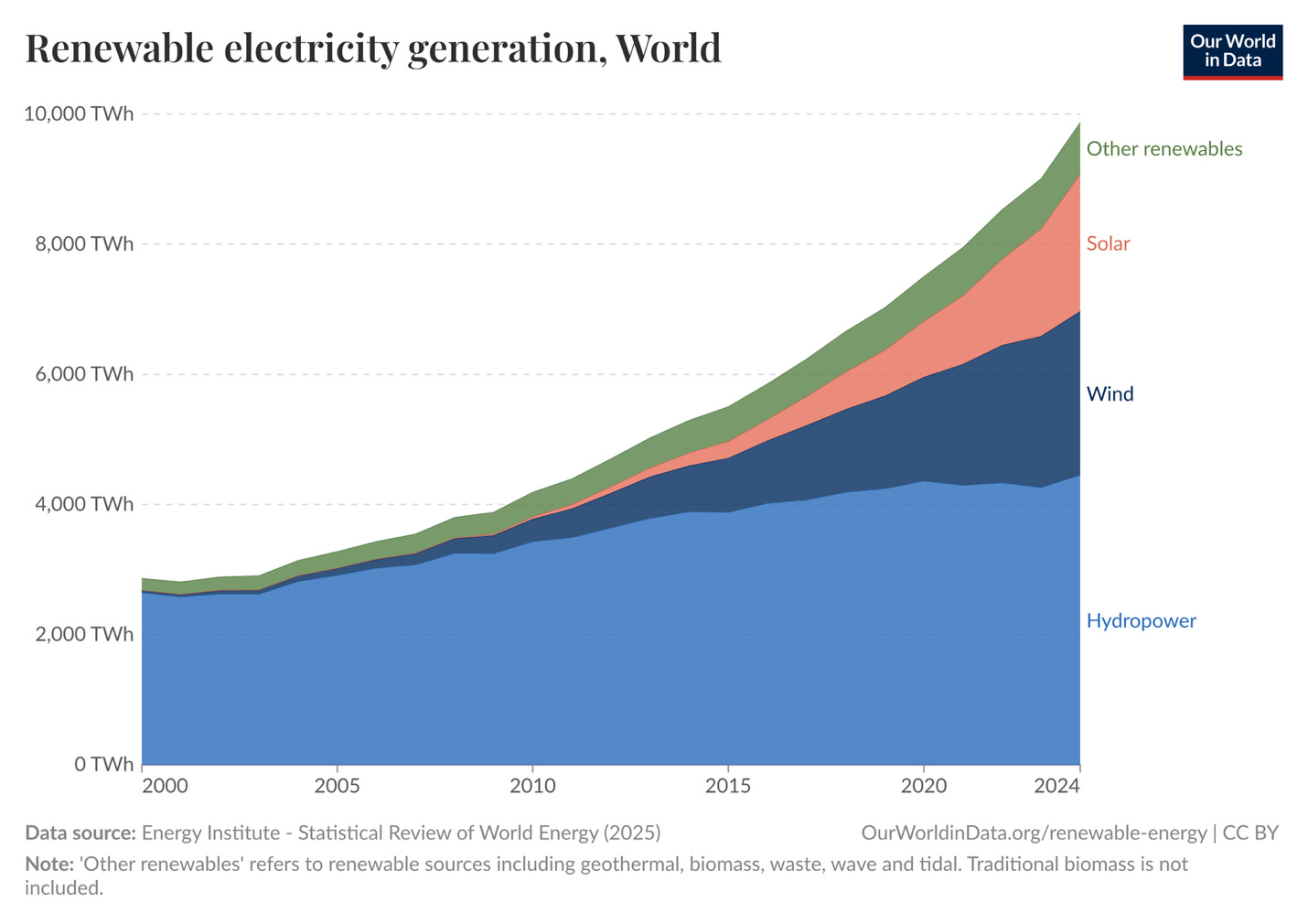
However, to understand the impact of the renewable revolution, it’s not enough to look at global application of these new technologies. It’s necessary to also look at international differences in adoption of renewables.
In this primer I will consider the world’s three economic superpowers: China, the United States, and the European Union. Granted, the Big Three by no means constitute the whole universe of energy policies. Combined, China, the U.S. and the E.U. only account for a little more than half of the world’s energy consumption. But by comparing and contrasting them I think we can learn a lot about possible energy futures.
A key finding is that while the technologies of the renewables revolution have been equally accessible to all of the Big Three, it is their willingness (or lack thereof) to adopt these technologies that have been the critical difference between them. Moreover, that difference in the willingness to adopt renewables appears set to grow going forward.
To see where things stand right now, let me offer two charts. The first shows renewables as a percentage of total energy consumption in 2024:
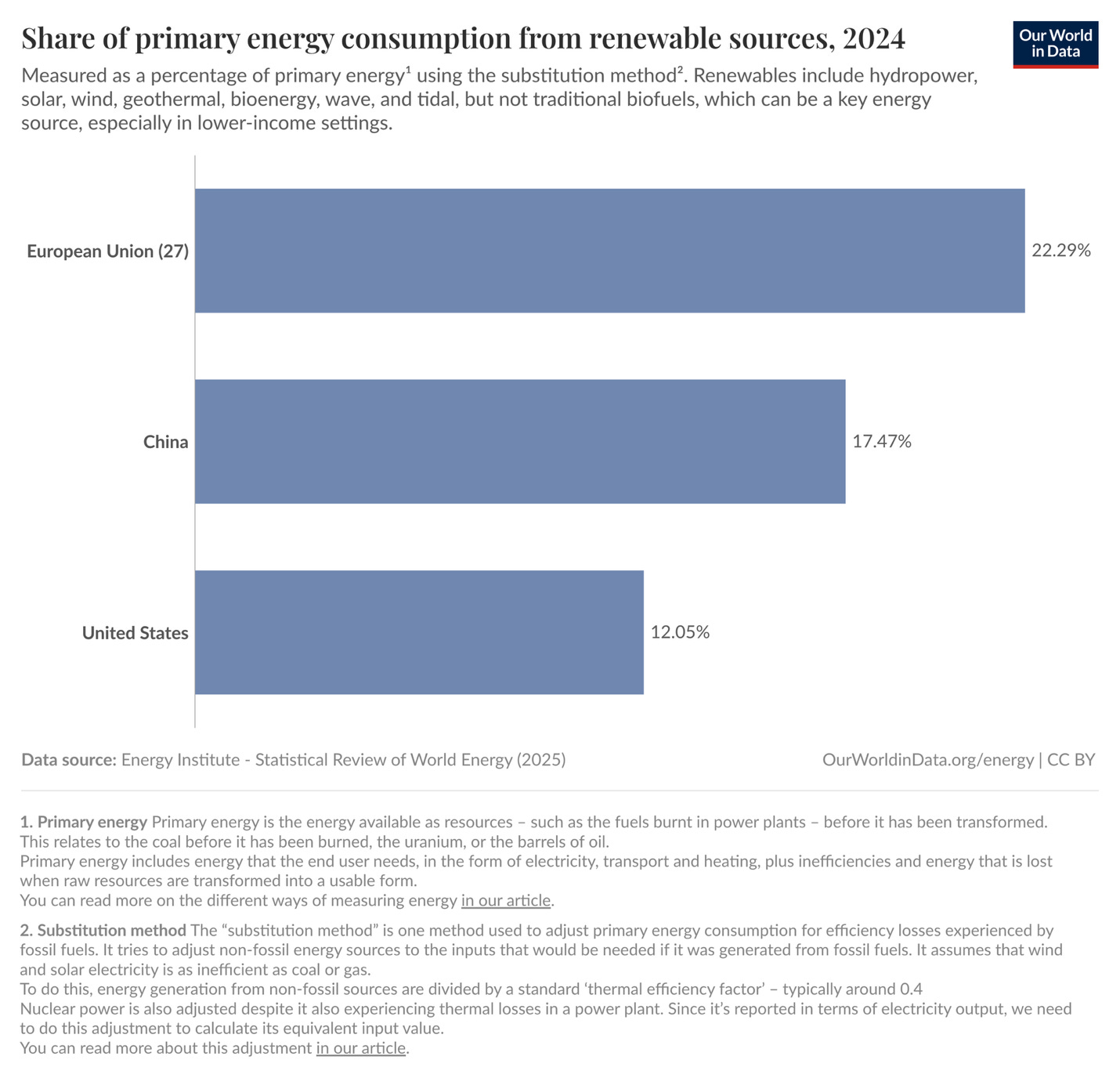
Since renewables are overwhelmingly used to generate electricity, the second chart shows the percentage of electricity generation powered by renewables:
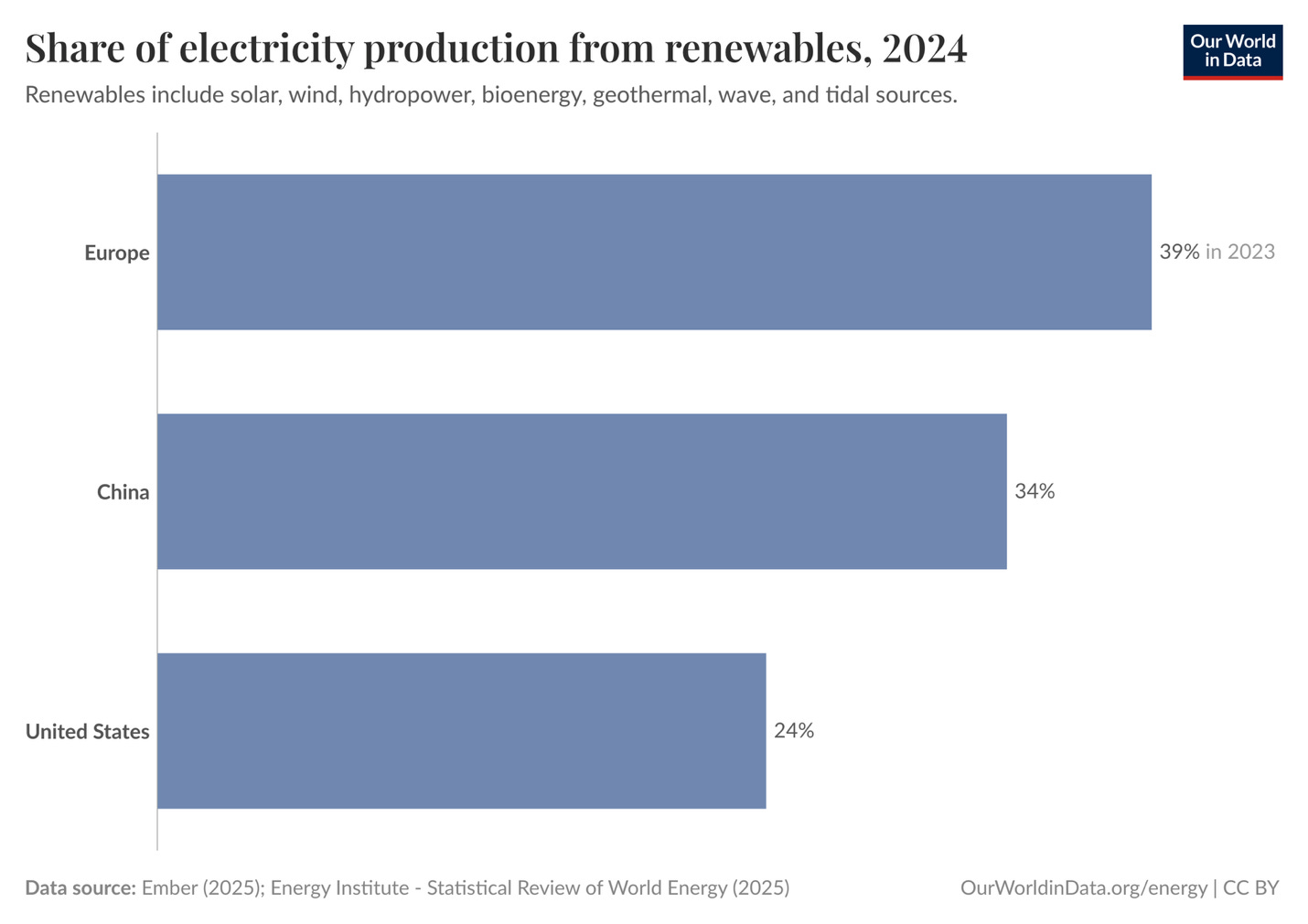
As both charts show, there is a clear ranking among the Big Three. Although China is by far the world’s largest producer of renewable energy, Europe clearly leads in the extent to which its economy has become renewables-based. America is a distant third on all criteria.
Why these differences? In large part it is due to politics, which gives rise to differences in government policies towards renewables.
So let’s start with America, where politics has severely hobbled the transition to renewables compared to China and the E.U.
America’s hostility to renewables
The U.S. hasn’t completely missed out on the renewable energy revolution. Let me repost a chart from last week’s primer, showing U.S. electricity production from renewables other than hydropower:
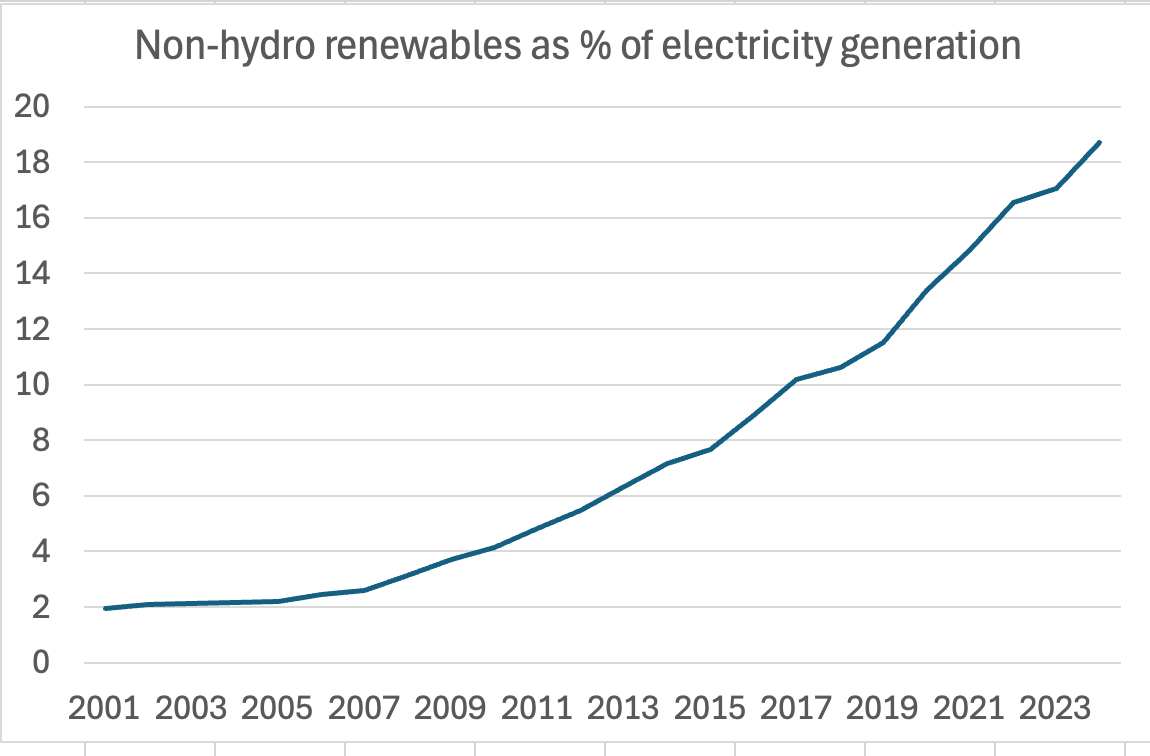
Source: Our World in Data
Despite the nearly 10-fold increase in the use of non-hydro renewables as a percentage of electricity generation over the past 20 years, however, America has lagged far behind Europe and China. Why?
The proximate explanation is that the other leading economies have been subsidizing and promoting clean energy on a much bigger scale than we have. Data are scrappy and hard to compare, but one source estimates that in 2022 the European Union spent more than 6 times as much as the U.S. promoting renewable energy, a gap that goes back at least to 2015. U.S. spending on renewables rose substantially during the last two years of the Biden administration, but this will presumably collapse given the Trump administration’s deep hostility.
Chinese data are, as always, very hard to interpret. But as I’ll explain later, China has a clear, ambitious industrial policy aimed at promoting green energy.
Since wading into politics is unavoidable, let me preface the political discussion by acknowledging that the American right’s hostility to renewables isn’t the only factor that has held green energy back. NIMBYism, largely from the left, has also been an important limiting factor.
Europe has shown that offshore wind farms can be a major, reasonably cost-effective source of electricity. They would be a natural way to expand renewable energy in the blue states of the Northeast U.S. But only a handful of offshore of offshore farms were approved during either the Obama or Biden administrations, in the teeth of fierce local opposition.
And now the Trump administration is taking extreme actions, possibly illegal, to block offshore wind farms, including some already under construction.
Varying degrees of left-leaning NIMBYism are surely the reason Texas, despite its political redness, gets a large share of its electricity from renewables, mainly wind, while New Jersey generates extraordinarily little renewable energy and continues to rely heavily on fossil fuels:


Source: New York Times
Thus the United States is exceptional for among advanced countries for the strength of political opposition to renewable energy. Initially, much of this opposition was attributable to the power of fossil fuel interests. The United States stands out among democracies both for the size of its fossil fuel sector and for the power of money in politics. So coal, oil and gas interests have played a uniquely important role in our politics.
Over time, however, this money-driven opposition to renewables has mutated into something deeper and more sinister: energy policy has become a victim of the culture wars.
A decade ago, many observers noted that the G.O.P. was the only major political party in the world that rejected climate science, simply denying that man-made climate change was happening. Since then, there has been a gradual downward trend in the number of Republican legislators espousing flat-out climate denial. But climate change denialism still has substantial support within the Republican Party.
Unsatisfied with just cutting off Biden’s green energy subsidies, Trump II has been actively moving to block renewable energy projects, sometimes on bizarre grounds that are probably illegal. I led this post with the cancellation of a major solar project. The East Coast was finally on the verge of a major expansion of offshore wind, but Trump’s officials have probably killed that. Just a few days ago RFK Jr. ordered the Centers for Disease Control to study the alleged adverse health impacts of offshore wind farms.
There’s much more one could say about U.S. energy policy, and I’ll surely return to the topic. For now, the important point is that America has basically opted out of participating in the renewable energy revolution.
Can Europe make the transition?
The European economy is the subject of a great deal of negativity, not least from Europeans themselves. But as I argued a few weeks back, Europe’s economy still has major strengths. It’s true that Europe has lagged in information technology. It has, however, been a leader in adopting renewable energy, a comparably important technology. As such, it has shown what can be done. But the big question is whether Europe can take the next step and truly wean itself from fossil fuels.
Most Western European nations generate more than half their electricity from renewables:
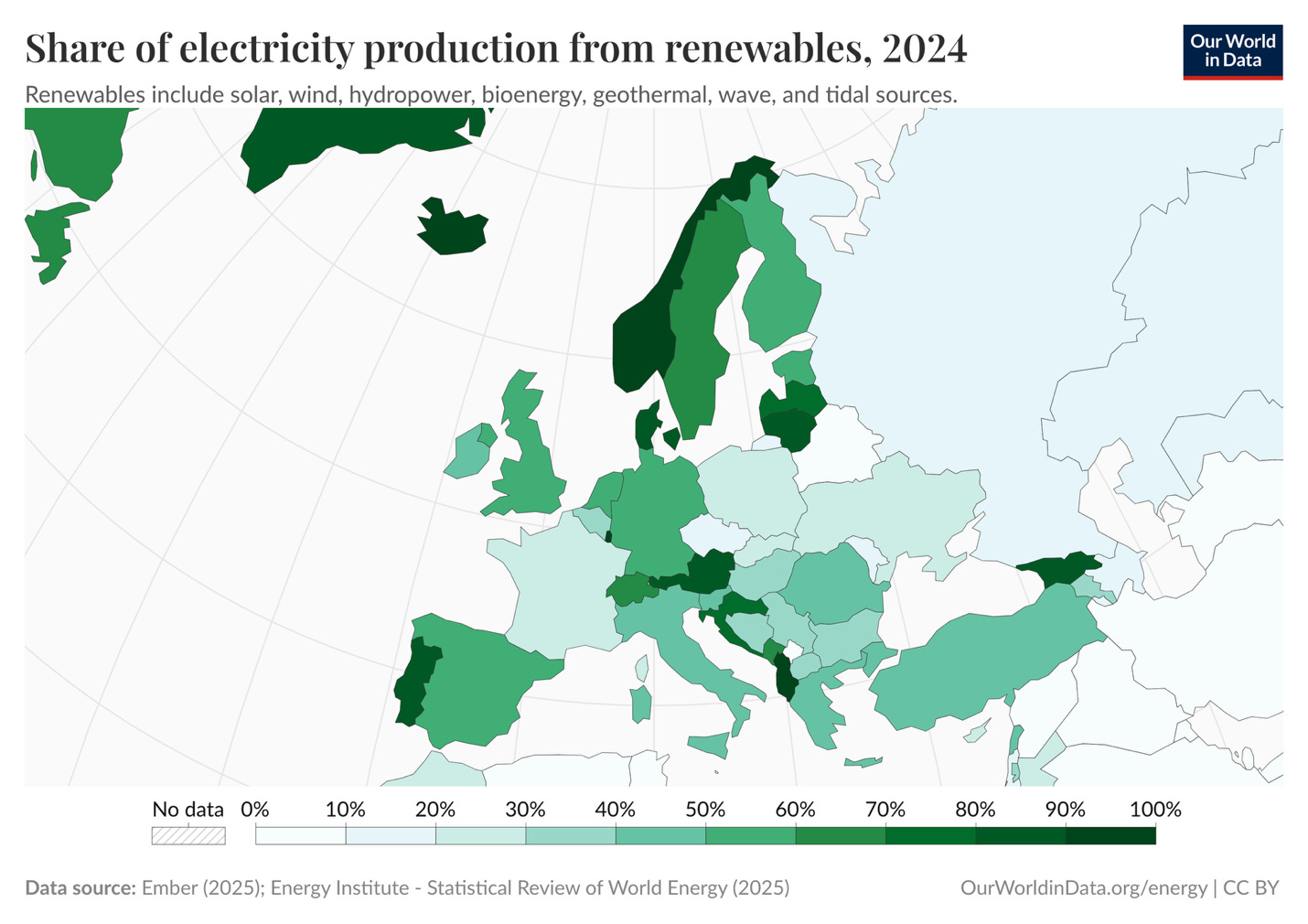
Some nations are almost entirely reliant on renewables, which generate 88 percent of electricity in Denmark and 85 percent in Portugal. France, by the way, isn’t an outlier because it relies heavily on fossil fuels. Instead, it has been uniquely successful at using nuclear power to generate a large share of its electricity.
The type of renewable energy used depends on the country. In northern Europe, wind power leads. Where the United States has had huge difficulty getting political approval for any offshore wind farms, the UK alone has dozens in operation — one of them, famously, visible from a golf course owned by an enraged Donald Trump — with more under construction:

Source: Wikipedia
Southern Europe makes significant use of wind power, mainly onshore, but relies even more on solar power.
Europe’s adoption of renewable energy for electricity generation remains incomplete, but it has gone far enough to demonstrate that replacing fossil fuels with wind and solar is possible. Yes, there have been occasional issues with grid management. But these will surely be worked out.
What Europe hasn’t done yet is electrify large parts of the economy that rely directly on fossil fuels, especially transportation. This will almost certainly be possible. But until it happens, we can’t yet say that Europe demonstrates the workability of a clean-energy future. All we can say so far is that Europe shows that it is possible to make far more use of renewable energy than we do in America.
The China energy paradox
China shifted away from being a centrally planned economy more than 40 years ago. It remains, however, a market economy with an asterisk — the government retains substantial ability to direct investment. And under President Xi, it has no hesitation in choosing and implementing industrial policies to shape the future of the Chinese economy — often in bare-knuckle fashion, as we saw watching him use China’s virtual monopoly on rare earths to put pressure on the United States.
The importance that China places on industrial policy means that one can’t measure China’s support for clean energy simply by looking at explicit subsidies. Rather, the true indicator of China’s intention is its explicit industrial policy of promoting solar and wind power, with the eventual goal of transitioning away from fossil fuels.
This strategy has made China the dominant global player in renewable energy growth. The chart at the top of this post showed levels of electricity generation from renewable energy. Here are the changes in renewable generation between 2019, just before Covid, and last year:
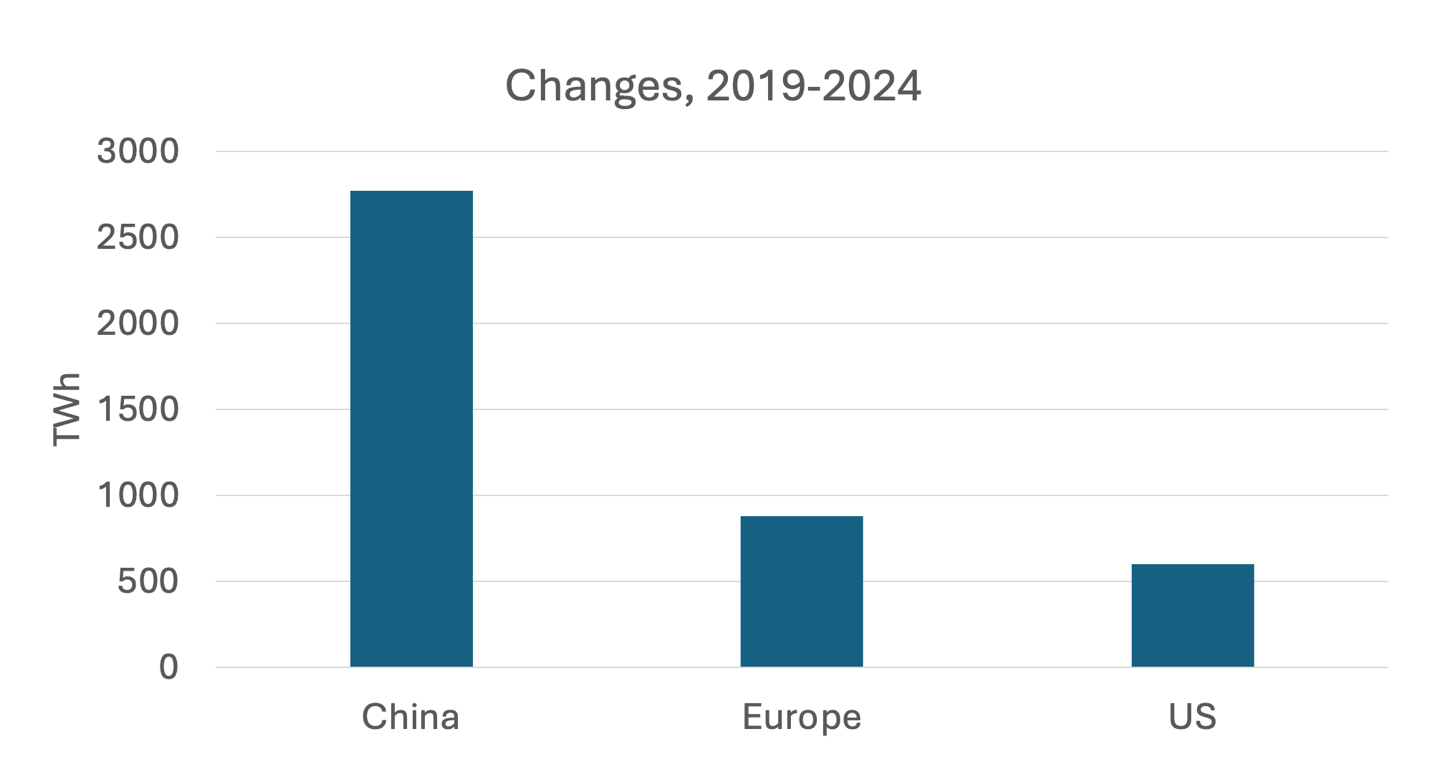
It’s only a slight exaggeration to say that the global rise in renewable energy is, at this point, basically a China story. That might have changed if the Biden administration’s green energy push had continued, but it didn’t. Instead the current U.S. government is trying, if anything, to force a transition back to fossil fuels. But from a global point of view this won’t matter much. China is where the action is.
In addition to dominating world growth in consumption of renewable energy, China has overwhelmingly dominated production of the equipment used to harvest and store renewable energy, from solar panels to turbine blades to batteries. This dominance presumably reflects both China’s manufacturing prowess and the size of its domestic market, which helps it export this equipment as well.
I won’t try to delve into China’s motivations in promoting renewable energy, largely because I know very little about Chinese political economy and won’t pretend otherwise.
Let me, instead, restrict myself to pointing out that we shouldn’t let the impressive scale of China’s renewable growth obscure one fundamental limitation on what has been achieved. When observers talk about an energy transition, they generally envision a substantial decline in use of fossil fuels, replaced by renewables. That hasn’t happened in China, at least so far.
One easy way to see China’s non-transition is to look at CO2 emissions from burning fossil fuels. While China’s use of renewable energy has surged over the past two decades, so have its emissions of greenhouse gases, as fossil fuel consumption has continued to rise:
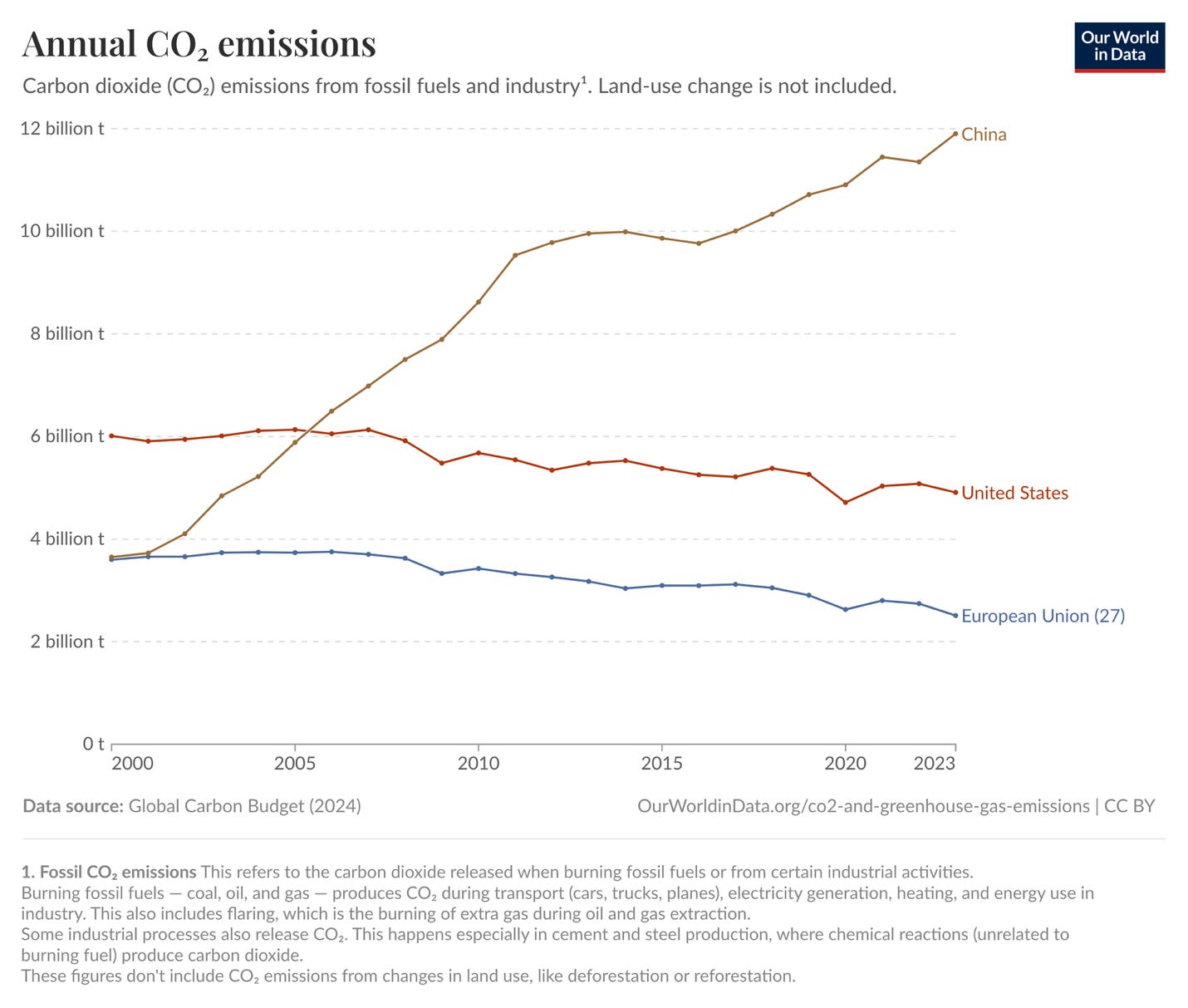
In fact, China still gets 35 percent of its electricity from coal, much higher than the share in Europe or the United States.
However, China’s latest five-year plan calls for even more massive investments in solar and wind. It seems plausible to say that China either has reached or soon will reach peak fossil fuel consumption.
Even this won’t be enough to eliminate the threat of catastrophic climate change. That would require a drastic reduction in emissions, which for all its ambitions China doesn’t seem set to achieve any time soon. But again, that’s a topic I’ll have to deal with another day.
What is clear is that renewable energy is a major technological advance — and that China is leaning hard into this technology, while the United States is taking a great leap backwards. This will obviously have huge consequences for geopolitics. But this primer is already long, so I’ll leave that discussion for next week
paulkrugman.substack.com |















